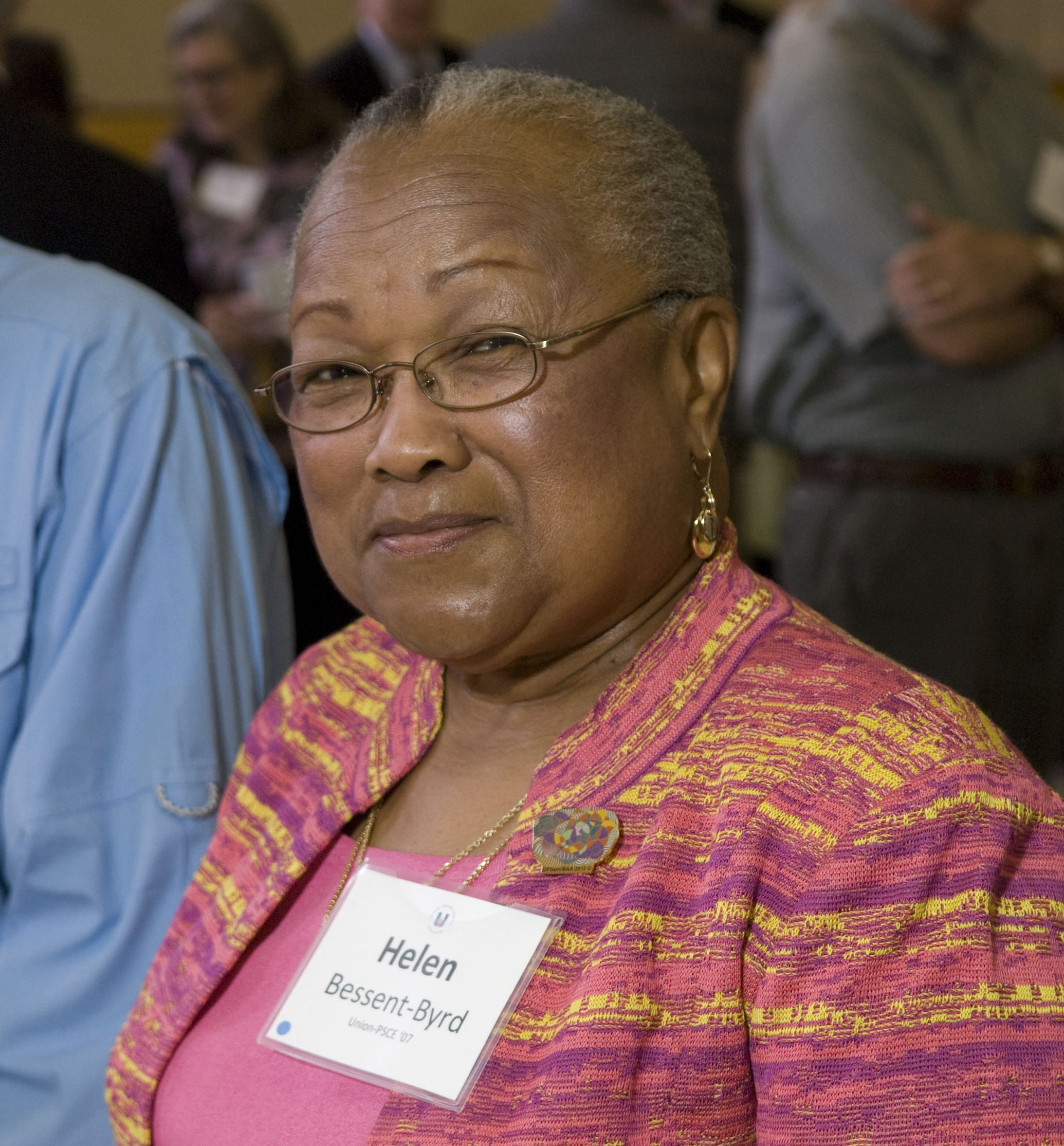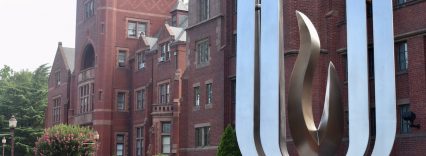Strange Bedfellows: South Africa and U.S.A.

By Rev. Dr. Helen Bessent Byrd, (Union-PSCE, M.Div’07)
Some of the locales and sights enjoyed in South Africa
At the end of September, 2019, one of my former colleagues and I traveled to one of the last places on our bucket lists to visit. We spent almost two weeks visiting South Africa and Victoria Falls in Zimbabwe. Musts among our chosen locales in South Africa were beautiful Cape Town and busy Johannesburg.
The Cape Town metropolis is much like the Hampton Roads Virginia area where we live in that it has beautiful beaches that attract many tourists. It has an inviting waterfront much like Baltimore’s Harbor Front and the San Francisco Fisherman’s Wharf entertainment area of shops, museums, restaurants, and theaters with attractive venues for walking, hiking and biking.
Very much unlike the flat sea level area where we travelers reside, juxtaposed against the beautiful beaches of Cape Town is the flat-topped Table Mountain that rises 3,563 feet above sea level. The mountain of slate and sandstone is home to vast varieties of flora and diverse fauna. I could not resist the opportunity to take the seven-minute cable ride up to the summit and look out on the beautiful city!
One of the experiences I anticipated most was the boat ride and visit to Robben Island to the now-closed prison where Nelson Mandela was incarcerated in isolation for 22 of his 27 years. On the Island, we took a bus ride over the grounds of this maximum security prison which is similar to Alcatraz on an island near San Francisco and Rikers in New York City two closed prisons in the U.S.A. We then walked to see Mandela’s small cell with bright light from a window too high to look outside and equipped with a container with lid, a small table with a metal plate on it and a rolled blanket on the floor. Surely, God sustained Mandela during those years. He remained sane, focused and pursuing the same goal for which he was imprisoned in the first place – freedom for his people.
Two additional features were of interest in Cape Town. We toured District Six, a community of 70,000 multi-ethnic residents. In 1966 they were displaced when the South African government decided that it was a place that white people should live. There are yet some empty lots in it. In the museum are relics from households of those times and a large scale map on the museum floor where people who lived there in the past are encouraged to label their old homes. The other site is a neighborhood of brightly colored houses in the Cape Malay neighborhood commonly referred to as Bo-Kapp neighborhood. Restaurants in that community sell dishes common to the people of the area.
After almost a week in Cape Town we flew north to Johannesburg and spent almost a week in the nation’s economic, financial and cultural hub. It is called Jo’burg or E’Goli (the City of Gold). This vibrant and busy state-of-the-art city still has glaring disparities such as sparkling skyscrapers and expensive homes of white Afrikaans and some East Indian merchants as well as shanty towns where many black Africans reside.
The recently relocated Long March to Freedom is a heritage monument that’s engaging, uplifting and absolutely worth a visit. It is a growing outdoor exhibit of well-designed life-size statues of heroes/heroines, chiefs/leaders, kings/queens and freedom fighters of South Africa with a few Africans and African Heritage persons from other nations. The 100 persons standing, walking, marching and riding horseback are only one-fourth of the planned congregation!
The best known of the shanty towns is Soweto which is called “the soul” of the nation and is where the struggle for democracy was born. This area was where black laborers were housed in shacks far from the city center. We went there to visit the Mandela House, now a national monument, where he lived from 1946 until 1961. Also located there is the Apartheid Museum, a graphic portrayal of the country’s move through oppression and the birth of democracy and a former home of Archbishop Desmond Tutu. The story is captured in photos, newspaper clippings, articles, documents such as identity cards and film. Seeing these heart-wrenching experiences tear at the fiber of one’s heart.
Black-White Relations in South Africa and the United States of America
Much like our nation, South Africa has a long history of struggle between the white economic, social and political leaders and the black Africans. In South Africa the black Africans are the indigenous peoples of the land. The white Afrikaans people came, took leadership, instituted apartheid (a strict practice of segregation of the white Afrikaans and the black Africans from the 1940s to the 1990s) and abandoned the Africans to less fertile lands away from properties that had been in their families for multiple generations.
It was my pleasure to serve on a national Task Force in 1981 for the United Presbyterian Church (U.S.A.) who convened with a Dutch Reformed Church of South Africa team to discuss The Church’s Responsibility in the Presence of Apartheid. We met with the South African team in London where they had come for another interdenominational meeting. For free reading during my travel, I carried the digest of the book, Creek Mary, from the Reader’s Digest. In this book of historical fiction by Dee Brown, he tells the story of Native American Indians who were forced out of their homelands to live on reservations. It follows the clan of Creek Mary for several generations. The Indians amicably shared some land with the European settlers along the southeast coast of Georgia and helped them to build their community. Gradually, the settlers required more and more land oppressing and dispossessing the Indians of their land as they were pushed further and further northwest. Having already read several books and articles about South Africa and its history of the Afrikaans taking land and resettling Africans, I was struck by the similarity of the callous and racist practices of my home country and South Africa. It was a moving experience to chair group discussions with church leaders about their role in helping to end apartheid. These two nations were strange bedfellows with some similar practices I did not learn about in my history classes! Fifteen years later, I was chairing the Mission Responsibility Through Investments (MRTI) Committee of the Presbyterian Church (U.S.A.) advising the national church on its financial investments with social screens, when the committee recommended, and the General Assembly divested shares of companies that cooperated with apartheid-practicing South Africa.
It was pleasing to observe, years later, the release of Nelson Mandela from prison, the move toward social and political relations across the color lines. After his election and under the careful leadership of the late Nelson Mandela, South Africa ended apartheid and moved to a more democratic majority-rule government. During our visit South African citizens were pleased to display and discuss their progress in race relations.
In the U.S.A. white Europeans came and settled in the 15thcentury, usurped control of the land from the many groups of indigenous peoples, named them all “American Indians” and corralled them in specified areas called reservations. Beginning in the seventeenth century the white Americans began the Transatlantic Trade System of importing black captives from Africa as chattel (the owning of human beings as property, with no freedom, that can be bought and sold, given or inherited) slaves.
Even though slavery in America, ended on December 6, 1865 with the passing of the 15th Amendment to the Constitution, our nation has progressed in racial understanding through the Reconstruction Period then regressed through the Jim Crow Period before the advances of the Civil Rights Movement which led to greater education, employment and political and opportunities for African Americans. The nation enjoyed the election of an African American president in 2008 who served two terms.
In the last decade, unfortunately, however, increased prejudice against African Americans and other minorities of color is being evident in loose discriminatory language, decreased affirmation programs, tightened immigration opportunities for people from Africa, South and Central America as well as certain Middle Eastern countries.
Seeing evidence of the struggle toward democracy of South Africa reminded me of America’s declaration of citizens’, “inalienable rights of life, liberty and the pursuit of happiness” while enslaving African captives. My visits to old slave markets and the Smithsonian National Museum of African American History and Culture as well as reading of a white great-great grandfather fighting with the South in the War Between the States and a great-great grandmother being sold to a white farmer all stir discomfort me equally.
Exploring the histories of the U.S.A. and South Africa together, I find that they are indeed strange bedfellows. It was a satisfying experience to see the progress in race relations in South Africa. There is very much work that remains to move toward balance in education, labor, and housing. And yes, it is good that we had two successful terms of leadership by President Barack Obama here in America. However, we are in difficult times now and have a long way to go to right the ship to attain “liberty and justice for all.” Praying progress for both nations and our global society, remembering Martin Luther King, Jr. who said, “We must develop a world perspective. No individual can live alone; no nation can live alone, and as long as we try, the more we are going to have war in the world.”
There is much to learn from the guides for the prison tours on Robben Island who are former prisoners and share their terrible experiences and the power of forgiveness. After his imprisonment, Mandela said, “As I walked out the door toward the gate that would lead me to my freedom, I knew if I didn’t leave my bitterness and hatred behind, I’d still be in prison.” The words are of much value to us Americans, black and white, as we seek to heal the wounds of pain and guilt from the past and become a democracy where all persons are treated equitably and can, “enjoy life, liberty and the pursuit of happiness”. Opening our hearts and minds to each other across racial lines will help us to forgive and move forward as individual nations. Amen. Ashe.
*M.Ed., Temple University; Ph.D., University of Connecticut; M.Div., Union Presbyterian Seminary








